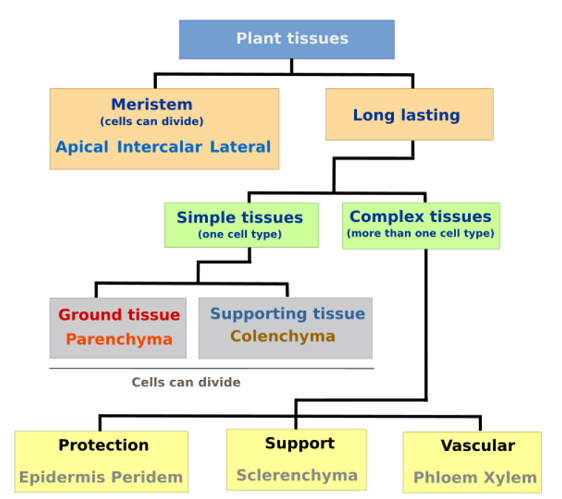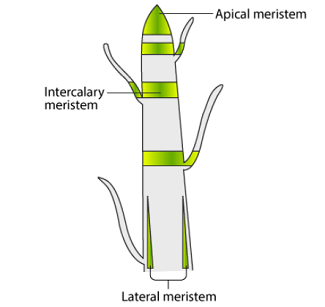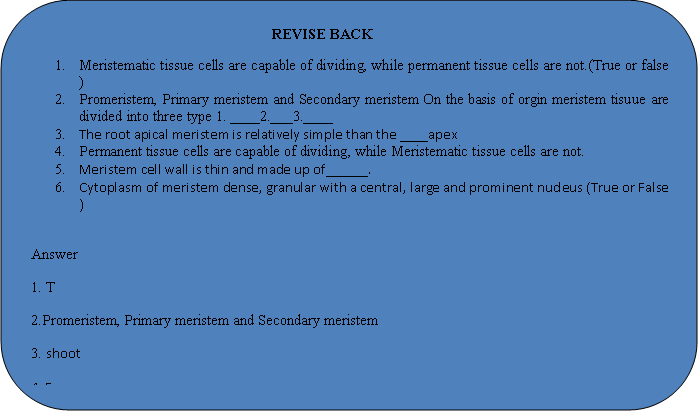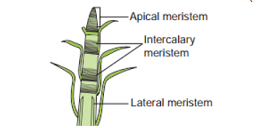
PLANT TISSUES
Tissue of Class 9
Plant tissues are of two types
- Meristematic tissue
- Permanent tissue
This differentiation is based on the ability of the mature cells of the tissue to divide and produce new cells. Meristematic tissue cells are capable of dividing, while permanent tissue cells are not.
CLASSIFICATION OF PLANT TISSUES:

- Meristematic Tissue: Totipotent cells are capable of giving rise to all the various cell types of the body of an organism.
Meristematic tiss ue, commonly called meristem (Gk. meristos: divisible) is composed of cells which possess the power of cell division. The term ‘meristem’ was introduced by C. Nageli (1858) for a group of continuously dividing cells.
CHARACTERISTICS OF MERISTEMSCells of meristems are living and are at active divisional stage. The cells are usually small and isodiametric. The cells of cambium are, however, elongated. The cells are compactly arranged without any intercellular spaces. The cell wall is thin and made up of cellulose. |

|
Cytoplasm is dense, granular with a central, large and prominent nucleus.
Vacuoles are either very small or absent. The cells of cambium are, however, vacuolated.
Metabolic activity is high, so is the rate of respiration.
Cytoplasm has all the cell organelles, but instead of plastids there are proplastids.
Ribosomes are abundant, ER is simple.
CLASSIFICATION OF MERISTEMS
Meristems have been classified on the basis of origin, position, function and plane of cell division.
| Basis | Types |
| Origin | Promeristem, Primary meristem and Secondary meristem |
| Position | Apical meristem, Lateral meristem and Intercalary meristem |
| Function | Protoderm, Procambium and Ground or Fundamental meristem |
| Plane of cell division | Rib meristem, Plate meristem and Mass meristem |
Meristems based on position
APICAL MERISTEM
The Meristem situated at the growing tips of root, shoot and their branches is called Apical meristem .
It is a primary meristem and is responsible for increase in length (primary growth) is called Apical meristem
LATERAL MERISTEM
The meristem situated on the sides of the axis of plants is called lateral meristem and is responsible for secondary growth.
Lateral meristems are secondary meristems, except intrafascicular cambium.
INTERCALARY MERISTEM
The meristem present at the nodal region of stem and its branches and intercalated between permanent cells is called intercalary meristem.
It may be present either at the base of internodes ( e.g., grasses, bamboo, wheat) or nodes (e.g., mint) or leaves (e.g., Pinus)
It is responsible for the elongation of internodes, increase in length and formation of lateral appendages.
It is short lived and very soon becomes permanent.
Differences between apical and lateral meristems :
| S. No. | Apical meristem | Lateral meristem |
| 1. | Occurs at the apex of stem, root and their branches. | Found in lateral position parallel to circumference of the organs. |
| 2. | It is a primary meristem. | It is secondary meristem. |
| 3. | Cells divide in different planes. | Cells divide in one plane periclinally both on the outer and inner sides. |
| 4. | It produces primary tissues. | It gives rise to secondary tissues. |
| 5. | It brings about growth in length. | It causes growth in girth and thickness. |
Fig. : Different types of meristem on the basis of position in plant body
In vascular plants the meristem which first appears in the embryonic shoot or embryonic root is known as apical meristem. All primary tissues of the plant body originate from the shoot and root apical meristem.
SHOOT APICAL MERISTEM
It is the terminal meristem of the shoot. It continuously gives rise to new cells and tissues from which new organs are formed.
Differences between vegetative shoot apex and reproductive shoot apex :
| Vegetative shoot apex | Reproductive shoot apex |
| Apex is conical or dome shaped. | Apex can be conical, flat or concave. |
| Growth activity is continuous and indefinite. | Growth activity is definite or determinate. |
| The apex is protected by young leaf primordia. | The apex is protected by calyx primordia. |
| Appendages are produced in spirals. | Formed in whorls. |
| It is not consumed. | It is consumed in the formation of floral parts. |
ROOT APICAL MERISTEM
The root apical meristem is relatively simple than the shoot apex. It is sub-terminal in position because root cap is present at the apex.
It is not associated with the formation of lateral appendages and differentiation of nodes and internodes.
Root apex does not show any distinction of tunica and corpus. It has central group of permanent initials, promeristems, produces 3−4 bands of temporary initials, called histogens .











